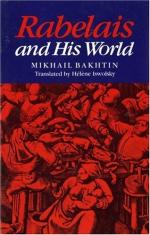
|
| Name: _________________________ | Period: ___________________ |
This test consists of 15 multiple choice questions and 5 short answer questions.
Multiple Choice Questions
1. Bakhtin connects Medieval "seriousness" most closely to:
(a) Fear, weakness, and violence.
(b) Scholarly activities.
(c) Feasting, spectacles, and sex.
(d) Inspiration and hope.
2. Rabelais expresses the debasement of suffering and fear by associating them with:
(a) Hunger.
(b) Religious fervor.
(c) Defecation.
(d) Sexual intercourse.
3. What was the most prevalent medium of the culture of the common folk in the Renaissance?
(a) The spoken word.
(b) Printed newspapers.
(c) Semaphore signals.
(d) Pantomime.
4. Did the "unofficial" and "official" forms of speech ever coincide?
(a) Yes, especially during festivals.
(b) No, except during times of war.
(c) Yes, except for religious holidays.
(d) No, both forms of speech were highly regulated.
5. How did Rabelais obtain the material for his writings?
(a) By attending many fairs and festivals and observing all the people there.
(b) By interviewing thousands of market vendors.
(c) By receiving a divine revelation.
(d) By studying manuscripts for long hours in monasteries.
6. Carnival allowed:
(a) The upper class to oppress relentlessly the lower class.
(b) The mixing of real and unreal, fantasy and fact.
(c) The endurance of the propriety expected of all social classes.
(d) The peasants to sell their crops without paying taxes.
7. Clowns and fools are:
(a) Prisoners forced to entertain others.
(b) Present only at large fairs or gatherings.
(c) Everyday representatives of the folk and of Carnival.
(d) Restricted to entertaining the royal court.
8. How are Bakhtin and Rabelais similar?
(a) They both write mostly novels.
(b) They both directly challenge the government by running for political office.
(c) They live in the same country.
(d) They both subvert the social prohibition on laughter, satire, and irony.
9. Why does Gargantua steal the bells of the Notre Dame cathedral?
(a) To celebrate his marriage.
(b) To decorate the harness of his horse.
(c) To sound the alarm for an impending invasion.
(d) To frighten the townsfolk of Paris.
10. With what is "folk culture" most concerned?
(a) The affairs of royalty.
(b) The lives of ordinary people.
(c) Foreign songs, art, and stories.
(d) Commerce and industry.
11. The combination of solemnity and joking in the tone of the Prologue to the Third Book indicates:
(a) The opinion that humor must be subordinate to seriousness.
(b) The importance and necessity of laughter.
(c) The complex explanation of the Prologue to the readers.
(d) The confusion the author experiences with this combination.
12. How, according to Bakhtin, does the current Russian literary criticism approach Rabelais' works?
(a) By trying to correctly interpret the source of the cultural laughter within them.
(b) By denouncing them as counterproductive to the ongoing Russian Revolution.
(c) By reviving their content in new, twentieth-century forms.
(d) By sharing them with an eager public.
13. How is the figure of the king treated in Rabelais' writing?
(a) Like a criminal: charged, tried, and punished.
(b) Like a god: worshipped, feared, and obeyed.
(c) Like a clown: beaten, travestied, and transformed.
(d) Like a child: pampered, sheltered, and beloved.
14. Comic rituals in Medieval and Renaissance Europe were:
(a) Freed of the trappings of religious dogma and mysticism.
(b) All that which linked the living to the dead.
(c) Necessary to mercantile transactions.
(d) Taboo in all settings but the royal court.
15. What does Bakhtin argue is the role of dialogue?
(a) To demonstrate thinking out loud.
(b) To move the plot along.
(c) To oppose the authoritarian word.
(d) To give one character a strong voice.
Short Answer Questions
1. What does Bakhtin consider the most indispensable element of folk culture?
2. What does Bakhtin find to be the greatest error other critics make in their studies of Rabelais' works?
3. What are the targets of the abusive language in Rabelais' prologue to the Third Book?
4. What style does Bakhtin find the prologue of _Pantagruel_ to be written in?
5. The verbal interactions between the Renaissance marketplace hawker and the crowd were above all:
|
This section contains 695 words (approx. 3 pages at 300 words per page) |

|




